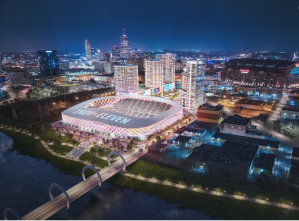Expert: Use Of Taxpayer Money For New Sports Stadiums Is Not Worth It
Expert Claims Use Of Taxpayer Money To Build New Sports Stadiums Is Not Worth It

Source: Courtesy of Indy Eleven / other
INDIANAPOLIS — City leaders in Indianapolis will put a plan proposed for a new soccer-specific stadium to be built to one final vote this week before sending the plan to the state for approval.
The Indianapolis City-County Council voted earlier this month in favor of a measure that will create a new tax district for a soccer stadium with the hope of attracting a Major League Soccer franchise to the Circle City.
Working out of order on the process due to timing being of the essence, the city’s Metro Development Commission will consider “PSDA2”, as it has come to be called, and will vote on the plan at their Wednesday meeting. If approved, which it likely will be, it will be sent to the State Budget Committee for their approval as well.
The measure’s full adoption by the city and state would be a big hurdle to clear for the city’s aspiration for an MLS team, even though the process has come to the chagrin of those in support of Indy Eleven, whose owners had a soccer stadium plan that the city back away from.
If all progresses as planned, a new soccer-specific stadium could be built where the Indianapolis Heliport currently sits in the next two to three years, which then begs the question: “Who will pay for it?”
The tax district likely to be created in the next couple of weeks will cover some of the cost, as will the mysterious ownership group spearheading the whole thing. But, the rest will be left up to taxpayer subsidies. This begs another question: “Are these stadiums really worth it?”
Many tourism experts and city leaders tout the building of new stadiums as an “economic boon” or a “huge opportunity for economic growth.” However, one economic expert says the research paints a much different picture.
“30 years of economic research uncovers no evidence whatsoever that attracting a new team and building that team a new stadium is associated with new increases in income, tax revenues, the whole thing,” said Brad Humphreys, a sports economist at West Virginia University, on Indy Politics.
The keywords, he says, are “new increases.” He argues that numbers show that publicly funded sports stadiums do not account for new spending and economic growth, but that they simply move that spending around within the local economy.
“These sporting events, and the games in these stadiums, they concentrate economic spending in and around the arena on game day,” he said. “That entertainment spending would have taken place somewhere else in the city at some other time instead of people going to the soccer stadium and spending money on parking and tickets and other sorts of things.”
Humphreys said the evidence is “solid” to prove that point.
He said many times these massive stadiums that are paid for with public money stand to benefit not those who are paying for it, but those who are building it like local politicians and developers who have a hand in the ownership of the teams that will end up occupying said stadiums.
Furthermore, he said sports team owners pushing for new stadiums typically want local governments in on paying for them in order to take advantage of possibly better credit ratings held by whatever city they are building in. Humphreys said this is essentially pushing the risk of the endeavor onto taxpayers through bonds issued by the government and not the owners themselves.
Humphreys said sports leagues are also treated differently under U.S. Anti-Trust Laws, which enables projects like these.



